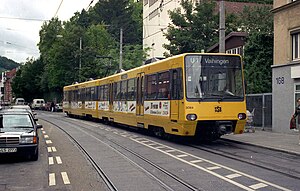SSB DT 8
| SSB DT 8 | |
|---|---|
 DT 8 street running in September 1995 | |
| Manufacturer | Duewag, Siemens, ADtranz, Stadler |
| Number in service | 204 sets (As of 2019[update])[1] |
| Number preserved | 2 cars |
| Formation | 2 cars per trainset |
| Capacity | 108 seated, 138 standing (DT8.10)[2] 106 seated, 144 standing (DT8.12)[3] |
| Specifications | |
| Train length | 38,050 mm (124 ft 10 in)[4] |
| Car length | 18,400 mm (60 ft 4 in)[4] |
| Width | 2,650 mm (8 ft 8 in)[4] |
| Height | 3,715 mm (12 ft 2.3 in)[4] |
| Floor height | 1,000 mm (3 ft 3 in)[4] |
| Doors | 2 pairs per car (per side) |
| Maximum speed | 80 km/h (50 mph) |
| Power output | 4 × 222 kW (298 hp) |
| Acceleration | 1,3 m/s |
| Deceleration | 1,3 m/s |
| Electric system(s) | 750 V DC overhead catenary |
| Current collector(s) | Pantograph |
| Coupling system | Scharfenberg |
| Track gauge | 1,435 mm (4 ft 8+1⁄2 in) standard gauge |
The SSB DT 8, also known as S-DT 8, is a type of light rail vehicle used on the Stuttgart Stadtbahn system.
Technical specifications
The trains are formed as two-car sets, with steel car bodies. Up to three sets can operate in multiple.[4] The DT8.10 trains are equipped with IGBT inverters and AC motors.[2] DT8.10 trains[2] and DT8.12 trains have air conditioning.[3]
History
Testing of three prototype trains began in 1982 on the Alb Valley Railway.[4]
First and second batch trains were built by multiple manufacturers, including Duewag, Siemens, and Bombardier.[5]
The first DT8.10 set was delivered in April 1999.[2]
20 Stadler Tango-based DT8.12 were ordered in 2010.[6] Additional 20 sets were ordered in 2014,[7] and further 20 sets were ordered in 2017.[8]
-
DT8.12 at the InnoTrans 2012
Preserved examples
Two prototype cars were formerly stored at Heslach depot, and were to be moved to the Straßenbahnwelt Bad Cannstatt in 2018.[9]
-
Cars 3001 and 3006 at the Straßenbahnmuseum Zuffenhausen in July 2007
References
- ^ "Stuttgart". Blickpunkt Straßenbahn (in German). Vol. 2/2019, no. 242. Arbeitsgemeinschaft Blickpunkt Straßenbahn e.V. 2019. p. 94. ISSN 0173-0290.
- ^ a b c d "Stuttgart goes AC motored". railwaygazette.com. DVV Media International. June 1, 1999. Archived from the original on June 4, 2020. Retrieved June 4, 2020.
- ^ a b Schulz-Braunschmidt, Wolfgang (January 15, 2014). "Die Stadtbahn-Flotte wächst weiter" [The Stadtbahn fleet keeps growing]. Stuttgarter Zeitung (in German). Archived from the original on March 2, 2017. Retrieved June 7, 2020.
- ^ a b c d e f g Schleife, Hans-Werner; et al. (1992). Metros der Welt [Metros of the world] (in German) (2nd ed.). transpress Verlagsgesellschaft. pp. 340, 341. ISBN 3-344-70715-9.
- ^ Griesser Kym, Thomas (May 17, 2019). "Stadler ist auf Zack: Stuttgart bestellt weitere Schienenfahrzeuge" [Stadler is on the ball: Stuttgart orders more rail vehicles]. St.Galler Tagblatt (in German). Archived from the original on June 7, 2020. Retrieved June 7, 2020.
- ^ "Stuttgart to order more light rail and rack railway vehicles". railwaygazette.com. DVV Media International. September 28, 2017. Archived from the original on June 7, 2020. Retrieved June 7, 2020.
- ^ Barrow, Keith (January 13, 2014). "Stuttgart orders more Stadler Tango LRVs". railjournal.com. Simmons-Boardman Publishing. Retrieved June 7, 2020.
- ^ Barrow, Keith (September 29, 2017). "Stuttgart Tramways approves order for 20 LRVs". railjournal.com. Simmons-Boardman Publishing. Retrieved June 7, 2020.
- ^ Bilger, Christine (July 18, 2018). "Auf den letzten Metern aus dem Gleis gesprungen" [Derailed on the last meters]. Stuttgarter Zeitung (in German). Archived from the original on June 7, 2020. Retrieved June 7, 2020.
External links
- SSB fleet information (in German)


